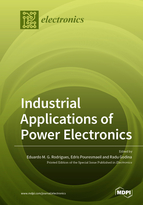Industrial Applications of Power Electronics
A special issue of Electronics (ISSN 2079-9292). This special issue belongs to the section "Power Electronics".
Deadline for manuscript submissions: closed (31 July 2020) | Viewed by 73919
Special Issue Editors
Interests: advanced industrial power electronics applications; instrumentation and signal acquisition; digital signal processing; maintenance engineering; advanced control techniques and implementation
Special Issues, Collections and Topics in MDPI journals
Interests: control of power electronics in power systems; integration of large-scale renewable energy sources into the low-inertia power grid; ICT-based power networks; smart grids; microgrid operation and control; simulator design and software development for smart grid applications
Special Issues, Collections and Topics in MDPI journals
Interests: industrial engineering; industrial symbiosis; energy management; sustainability; circular economy; additive manufacturing; lean manufacturing; quality management systems; sustainable energy systems
Special Issues, Collections and Topics in MDPI journals
Special Issue Information
Dear Colleagues
In recent years, power electronics have been intensely contributing to the development and evolution of new structures for the processing of energy. It is becoming very common to generate electrical energy in different ways and convert it into another form in order to be able to use it—for instance, renewable sources, battery banks, and the transmission of electric power in direct current (DC), which make available the voltage of the network in different levels in detriment to the supplied voltage from the grid. The main users of these signals are the electronic equipment that use voltages at levels different from that available from the grid; the drives of electrical machines, which modify the voltage of the electrical network (amplitude and frequency) to control the machines; and finally in electrical systems, DC power transmission and frequency conversion.
Two leading trends are currently noticeable in the power systems field of study. The first trend is the increasingly and prevalent employment of renewable energy resources. The second trend is decentralized energy generation. This scenario raises many challenges. Therefore, the design, development, and optimization of power electronics and controller devices are required in order to face such challenges. New microprocessor control units (MCUs) could be utilized for power production control and for remote control operation, while power electronic converters are and could be utilized to control the power flow.
Nevertheless, power electronics can be used for a wide range of applications, from power systems and electrical machines to electric vehicles and robot arm drives. In conjunction with the evolution of microprocessors and advanced control theories, power electronics is playing an increasingly essential role in our society.
Thus, in order cope with the obstacles lying ahead, original studies and modeling methods can be developed and proposed that could overcome the physical and technical boundary conditions and at the same time consider technical, economic, and environmental aspects. The objective of this Special Issue is to present studies in the field of electrical energy conditioning and control using circuits and electronic devices, with emphasis on power applications and industrial control. Therefore, researchers are invited to submit their manuscripts to this Special Issue and contribute their models, proposals, reviews, and studies.
Prof. Dr. Eduardo M. G. Rodrigues
Prof. Dr. Edris Pouresmaeil
Dr. Radu Godina
Guest Editors
Manuscript Submission Information
Manuscripts should be submitted online at www.mdpi.com by registering and logging in to this website. Once you are registered, click here to go to the submission form. Manuscripts can be submitted until the deadline. All submissions that pass pre-check are peer-reviewed. Accepted papers will be published continuously in the journal (as soon as accepted) and will be listed together on the special issue website. Research articles, review articles as well as short communications are invited. For planned papers, a title and short abstract (about 100 words) can be sent to the Editorial Office for announcement on this website.
Submitted manuscripts should not have been published previously, nor be under consideration for publication elsewhere (except conference proceedings papers). All manuscripts are thoroughly refereed through a single-blind peer-review process. A guide for authors and other relevant information for submission of manuscripts is available on the Instructions for Authors page. Electronics is an international peer-reviewed open access semimonthly journal published by MDPI.
Please visit the Instructions for Authors page before submitting a manuscript. The Article Processing Charge (APC) for publication in this open access journal is 2400 CHF (Swiss Francs). Submitted papers should be well formatted and use good English. Authors may use MDPI's English editing service prior to publication or during author revisions.
Keywords
- power converters
- electrical machines
- power grid stability analysis
- power network analysis and control
- power electronics switching devices
- simulations of power electronic systems
- renewable power generation technologies
- industrial, commercial, and residential applications
- solar inverters
- power control of wind turbines
- motor drives
- power semiconductor devices
- multilevel converters
- fault diagnosis in electrical machines
- power supplies
- converters in microgrid applications
- power electronics in smart grid
- manufacturing of components and assemblies used in power electronics
- manufacturing, quality, and testing of power electronics equipment
- electric/hybrid vehicle converters
- power quality, harmonics, and reactive power compensation
- electromagnetic compatibility (EMC) and electromagnetic interference (EMI)
Related Special Issue
- Industrial Applications of Power Electronics II in Electronics (5 articles)








